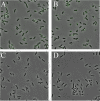Cellular Stoichiometry of Methyl-Accepting Chemotaxis Proteins in Sinorhizobium meliloti
- PMID: 29263102
- PMCID: PMC5826028
- DOI: 10.1128/JB.00614-17
Cellular Stoichiometry of Methyl-Accepting Chemotaxis Proteins in Sinorhizobium meliloti
Abstract
The chemosensory system in Sinorhizobium meliloti has several important deviations from the widely studied enterobacterial paradigm. To better understand the differences between the two systems and how they are optimally tuned, we determined the cellular stoichiometry of the methyl-accepting chemotaxis proteins (MCPs) and the histidine kinase CheA in S. meliloti Quantitative immunoblotting was used to determine the total amount of MCPs and CheA per cell in S. meliloti The MCPs are present in the cell in high abundance (McpV), low abundance (IcpA, McpU, McpX, and McpW), and very low abundance (McpY and McpZ), whereas McpT was below the detection limit. The approximate cellular ratio of these three receptor groups is 300:30:1. The chemoreceptor-to-CheA ratio is 23.5:1, highly similar to that seen in Bacillus subtilis (23:1) and about 10 times higher than that in Escherichia coli (3.4:1). Different from E. coli, the high-abundance receptors in S. meliloti are lacking the carboxy-terminal NWETF pentapeptide that binds the CheR methyltransferase and CheB methylesterase. Using transcriptional lacZ fusions, we showed that chemoreceptors are positively controlled by the master regulators of motility, VisNR and Rem. In addition, FlbT, a class IIA transcriptional regulator of flagellins, also positively regulates the expression of most chemoreceptors except for McpT and McpY, identifying chemoreceptors as class III genes. Taken together, these results demonstrate that the chemosensory complex and the adaptation system in S. meliloti deviates significantly from the established enterobacterial paradigm but shares some similarities with B. subtilisIMPORTANCE The symbiotic soil bacterium Sinorhizobium meliloti is of great agricultural importance because of its nitrogen-fixing properties, which enhances growth of its plant symbiont, alfalfa. Chemotaxis provides a competitive advantage for bacteria to sense their environment and interact with their eukaryotic hosts. For a better understanding of the role of chemotaxis in these processes, detailed knowledge on the regulation and composition of the chemosensory machinery is essential. Here, we show that chemoreceptor gene expression in S. meliloti is controlled through the main transcriptional regulators of motility. Chemoreceptor abundance is much lower in S. meliloti than in Escherichia coli and Bacillus subtilis Moreover, the chemoreceptor-to-kinase CheA ratio is different from that of E. coli but similar to that of B. subtilis.
Keywords: alfalfa; chemoreceptors; flagellar motor; plant symbiosis; transcriptional control.
Copyright © 2018 American Society for Microbiology.
Figures




References
Publication types
MeSH terms
Substances
LinkOut - more resources
Full Text Sources
Other Literature Sources

